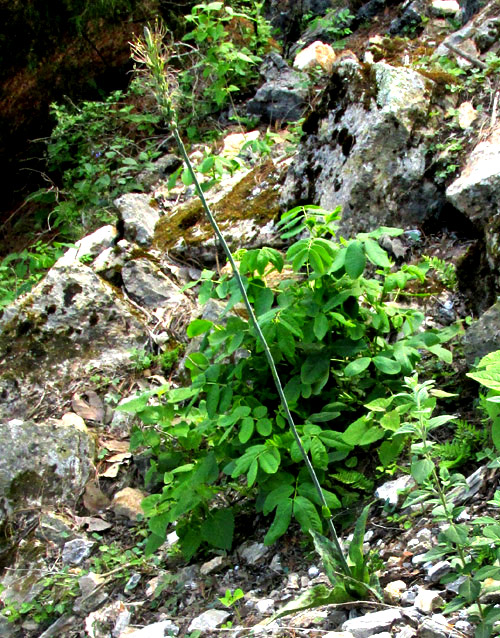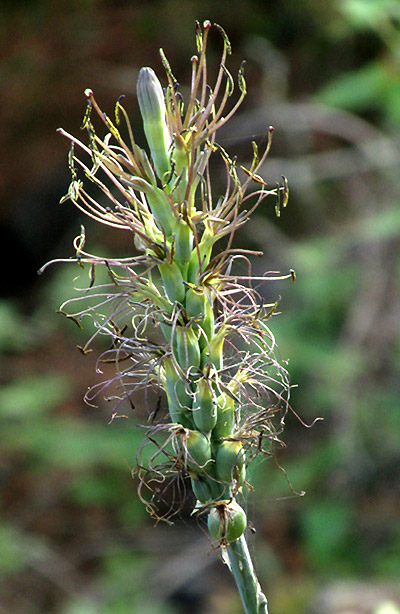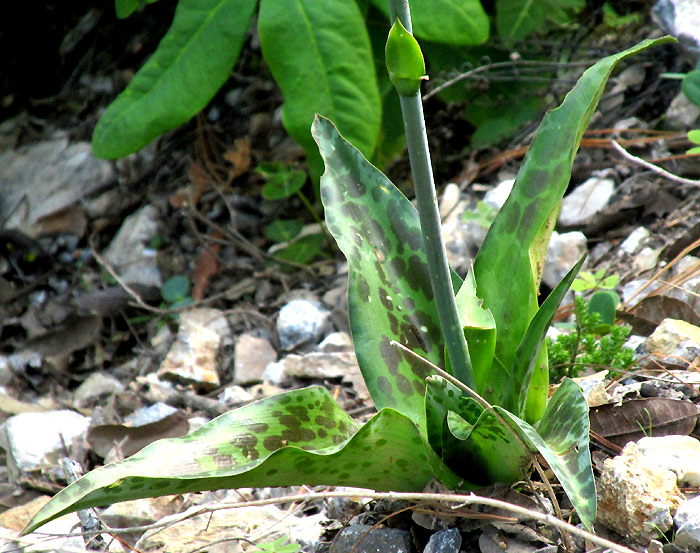Excerpts from Jim Conrad's
Naturalist Newsletter
Entry from field notes dated September 1, 2023, taken in Los Mármoles National Park in the Eastern Sierra Madre mountains, Hidalgo state, MÉXICO, along steeply climbing road heading eastward out of town of Trancas {on maps designated "Morelos (Trancas)"} toward Nicolás Flores; juniper/pine forest on limestone bedrock; elevation ~2,300m (~7,550ft); ~N20.80°, ~W99.24°
SPOTTED FALSE AGAVE

Here we're looking at the rosette of sharply tipped leaves at the above picture's bottom, right corner. A slender, stiff flower stalk issues from the rosette and passes diagonally across the picture. This plant can pass unnoticed in such a jumbled-up environment. Here's what the flowers looked like atop the flowering stalk:

We're lucky to catch the plant in full bloom, its inflorescence bristling with stamens and styles. An important feature to notice in the above photo is that the tightly packed flowers arise individually from the flowering stem, or rachis, not in clusters of two or more.

Above, a single blossom is featured, its base at the picture's lower right. In that corner, the green, oblong form is the ovary atop which a perianth tube arises. Perianths consist of both calyxes and corollas, and many perianths don't produce such tubes. Atop our flower's tube, six slender tepals arise. The term tepal is used when petals and sepals are indistinguishable. Six stamens arise from within the ring of tepals; the stamens' black anthers shed yellow pollen at the picture's top, left corner. With the perianth tube and stamens arising atop the ovary, not at its base, we have an inferior ovary, which is a detail important to notice for identification purposes. The closely related Lily Family, for instance, produces superior ovaries with perianth and stamens arising at ovary bases. In the picture, the ovary's style, tipped with a whitish stigma, overtops the anthers.

Our plant's leaves were conspicuously spotted, adding to the camouflage effect, for the random spotting was in agreement with surrounding randomly arranged and randomly sized rocks.
In recent years plants like ours resided in the Agave Family, the Agavaceae, but in 2009 that family ceased to exist when it was sunk into the Asparagus Family, the Asparagaceae. Similarly, identification of our plant using older literature directs us to the genus Manfreda, whose species often were called false agaves. However, Manfreda has been subsumed into the genus Agave, so our plant is a false agave, which really is an Agave, so it's a real agave despite still being called in English a false agave.
No modern botanical treatment exists detailing differences between agave species appearing in our area, but using identified photos on the Internet, which sometimes are misidentified, and noting which species are listed for our part of upland central Mexico, is a shaky way to identify a plant. Still, using pictures and lists, it appears that our plant is either Agave guttata or Agave pringlei. The comprehensive 2022 study by José Luis Villaseñor and others entitled "Riqueza y distribución de la flora vascular del estado de Hidalgo, México lists only one of those two candidate species as occurring here in Hidalgo state, and that's Agave pringlei.
However, on the Internet I find a dried herbarium specimen of Manfreda guttata, now Agave guttata, collected not only in Hidalgo and Mármoles National Park, but possibly at the same location as our picture taking. On that collection's herbarium sheet label it's noted that the collection was made at "brecha Trancas-Puerto de Piedra, justo en la desviación hacia Nicolás Flores" -- near where the road from Trancas to Nicolás Flores forks with the road to Puerto de Piedra. That specimen is on file at UNAM, Mexico's main university, and is known as MEXU 5250. To me, our plant looks more like AGAVE GUTTATA.
The leaves of our Agave guttata tend to be wider than those of Agave pringlei, and the latter's leaves usually bear no spots, though I read that sometimes they do. Also, on Agave pringlei flowers, the perianth tube tends to be proportionally longer and more slender than seen on Agave guttata.
Agave guttata is endemic mainly to Mexico's central plateau region at elevations of 1800-2400m (5900-7900ft). It's found in grasslands, rocky hills and roadsides.
Sometimes among xeriscaping gardeners and pot-growers of succulents our agave is known by the name of Spotted False Agave.
Robert Bye Jr.'s 1986 classic "Medicinal Plants of the Sierra Madre: Comparative Study of Tarahumara and Mexican Market Plants," tells us that among the Tarahumara the roots of Agave guttata traditionally were used for washing hair and clothing. Certain agave species are recognized as having saponine-rich roots; pound the roots in water and soapy suds develops.